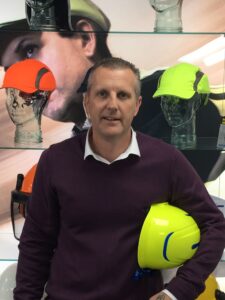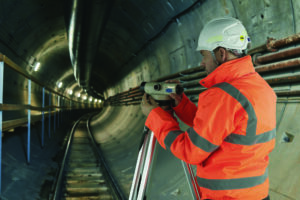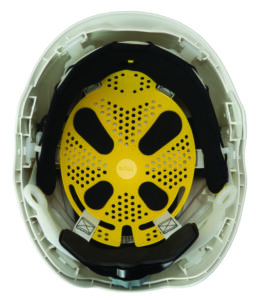There is a common misconception that the biggest risk to our heads comes from falling objects, but accident statistics tell a different story, Chris Tidy Technical & Training Specialist at Centurion Safety explains more.
 Many of us have seen EN397 safety helmet shock tests where a linear force is directed onto a safety helmet from height and in most cases the hard hat remains intact. This type of test is a sobering reminder of the importance of wearing head protection and demonstrates that these kind of safety helmets are relatively good at absorbing linear impacts.
Many of us have seen EN397 safety helmet shock tests where a linear force is directed onto a safety helmet from height and in most cases the hard hat remains intact. This type of test is a sobering reminder of the importance of wearing head protection and demonstrates that these kind of safety helmets are relatively good at absorbing linear impacts.
The problem is that most traumatic head injuries are not caused by a linear impact to the crown of the safety helmet. In fact, research shows that you are nine times more likely to acquire a long-term injury from a fall than to get the same injury outcome from a falling object but, when falling objects do cause injuries they rarely fall straight down and cause a linear impact – for example, when a brick falls it might hit the scaffolding or re-bound off some hoarding before striking the safety helmet with a non-linear impact.
In both cases, the impact to the head, is more likely to cause a rotational motion which is quite different to the testing in EN397 which focuses on linear impact only.
However, before we discuss protection, let us look a bit closer at brain injuries caused byrotational motion.
What is a rotational injury?
A rotational brain injury is the result of a rapid change of the rotational velocity of the head. This rapid change can be caused by a direct hit to the helmet or the skull or by an indirect hit to the shoulder leading to a rotational motion of the head. Linear acceleration injuries result from straight line forces that compress or stretch the brain within the skull. In contrast, rotational acceleration injuries result from non-linear forces that twist/shear the brain within the skull. Brain tissue deformation hence, damage is mainly caused by shear rather than compression or tension due to its mechanical properties. Therefore, most traumatic brain injuries are caused by rotational acceleration.
How do rotational impacts affect the brain?

Although linear acceleration injury and rotational acceleration injury can often occur together, there are some important differences. Linear acceleration injury is often associated with focal brain injuries, whereas rotational acceleration injuries more commonly involve both focal and diffuse brain injury. (Holburn, A. H. S. (1943). Mechanisms of head injury. Lancet, 245, 438–441).
Focal brain damage occurs from contact injuries resulting in contusion, laceration, and intracranial haemorrhage, while diffuse brain damage occurs mainly due to acceleration/deceleration injuries resulting in diffuse axonal injury or brain swelling. The outcome from head injuries varies significantly depending on the type of impact sustained.
What does this mean for normal safety helmets?
Safety helmets are relatively good at absorbing linear impacts, such as the EN397 impact test. If the safety helmet you are wearing has a liner, then this is improved slightly. The problem arises when you have an impact and experience rotational acceleration. The helmet then slides across the head grabbing the skull and rotating it along with the directional force of the impact. This can of course not only occur because of slips, trips, and falls from the same level or one level above, but also from dropped objects striking you. This may also include side swipes from machinery – say a digger operator turning suddenly and striking you with the bucket.
What is clear is that the risk of rotational injury has, until recently, been poorly understood and a large proportion of safety helmets are not currently designed to protect against rotational impact at all.
Why four layers are better than two
 At Centurion innovation is our drumbeat and we are constantly looking at how we offer improved wearer protection. In March, we launched the Nexus Extreme safety helmet, which is the first safety helmet to offer a four-layer system of protection. The helmet includes a pure grade ABS Shell that has been designed to dissipate the impact energy. The second layer, an EPS Liner, has been designed to decelerate the impact. These are combined with a third layer, a Cradle which is designed to reduce shock. The fourth layer has been produced by forming a partnership with the helmet technology company Mips to develop the world’s first Multi-directional Impact Protection System for an industrial helmet that has a cradle. Mips multi-directional impact protection system is a low frictional layer designed to reduce rotational motion transferred to the brain from angled impacts to the head.
At Centurion innovation is our drumbeat and we are constantly looking at how we offer improved wearer protection. In March, we launched the Nexus Extreme safety helmet, which is the first safety helmet to offer a four-layer system of protection. The helmet includes a pure grade ABS Shell that has been designed to dissipate the impact energy. The second layer, an EPS Liner, has been designed to decelerate the impact. These are combined with a third layer, a Cradle which is designed to reduce shock. The fourth layer has been produced by forming a partnership with the helmet technology company Mips to develop the world’s first Multi-directional Impact Protection System for an industrial helmet that has a cradle. Mips multi-directional impact protection system is a low frictional layer designed to reduce rotational motion transferred to the brain from angled impacts to the head.
In fact, the impact on protection levels of the Mips technology combined with the Nexus design is so significant we see the introduction of the Mips cradle into hardhats as a watershed moment for the head protection market and the reaction of potential customers so far has reinforced this view.
Approaches to managing the risks associated Musculoskeletal disorders
In this episode of the Safety & Health Podcast, we hear from Matt Birtles, Principal Ergonomics Consultant at HSE’s Science and Research Centre, about the different approaches to managing the risks associated with Musculoskeletal disorders.
Matt, an ergonomics and human factors expert, shares his thoughts on why MSDs are important, the various prevalent rates across the UK, what you can do within your own organisation and the Risk Management process surrounding MSD’s.

 Many of us have seen EN397 safety helmet shock tests where a linear force is directed onto a
Many of us have seen EN397 safety helmet shock tests where a linear force is directed onto a 


Thanks